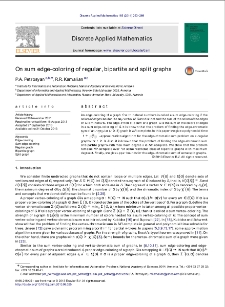Object
Title: On sum edge-coloring of regular, bipartite and split graphs
Co-author(s) :
Abstract:
An edge-coloring of a graph G with natural numbers is called a sum edge-coloring if the colors of edges incident to any vertex of G are distinct and the sum of the colors of the edges of G is minimum. The edge-chromatic sum of a graph G is the sum of the colors of edges in a sum edge-coloring of G. It is known that the problem of finding the edge-chromatic sum of an r-regular (r≥3) graph is NP-complete. In this paper we give a polynomial time (1+2r(r+1)2)-approximation algorithm for the edge-chromatic sum problem on r-regular graphs for r≥3. Also, it is known that the problem of finding the edge-chromatic sum of bipartite graphs with maximum degree 3 is NP-complete. We show that the problem remains NP-complete even for some restricted class of bipartite graphs with maximum degree 3. Finally, we give upper bounds for the edge-chromatic sum of some split graphs.
Publisher:
Date submitted:
Date accepted:
Date of publication:
Identifier:
oai:noad.sci.am:136141
DOI:
ISSN:
Language:
Journal or Publication Title:
Volume:
URL:
Affiliation:
Institute for Informatics and Automation Problems ; Russian-Armenian State University ; Department of Applied Mathematics and Informatics
Country:
Indexing:
Object collections:
- Digital Library > Academic Insitutions > Insitute for Informatics and Automation Problems of NAS RA > Publications
Last modified:
Apr 19, 2021
In our library since:
Apr 19, 2021
Number of object content hits:
210
All available object's versions:
https://noad.sci.am/publication/149562
Show description in RDF format:
Show description in OAI-PMH format:
| Edition name | Date |
|---|---|
| Petros Petrosyan, On sum edge-coloring of regular, bipartite and split graphs | Apr 19, 2021 |





